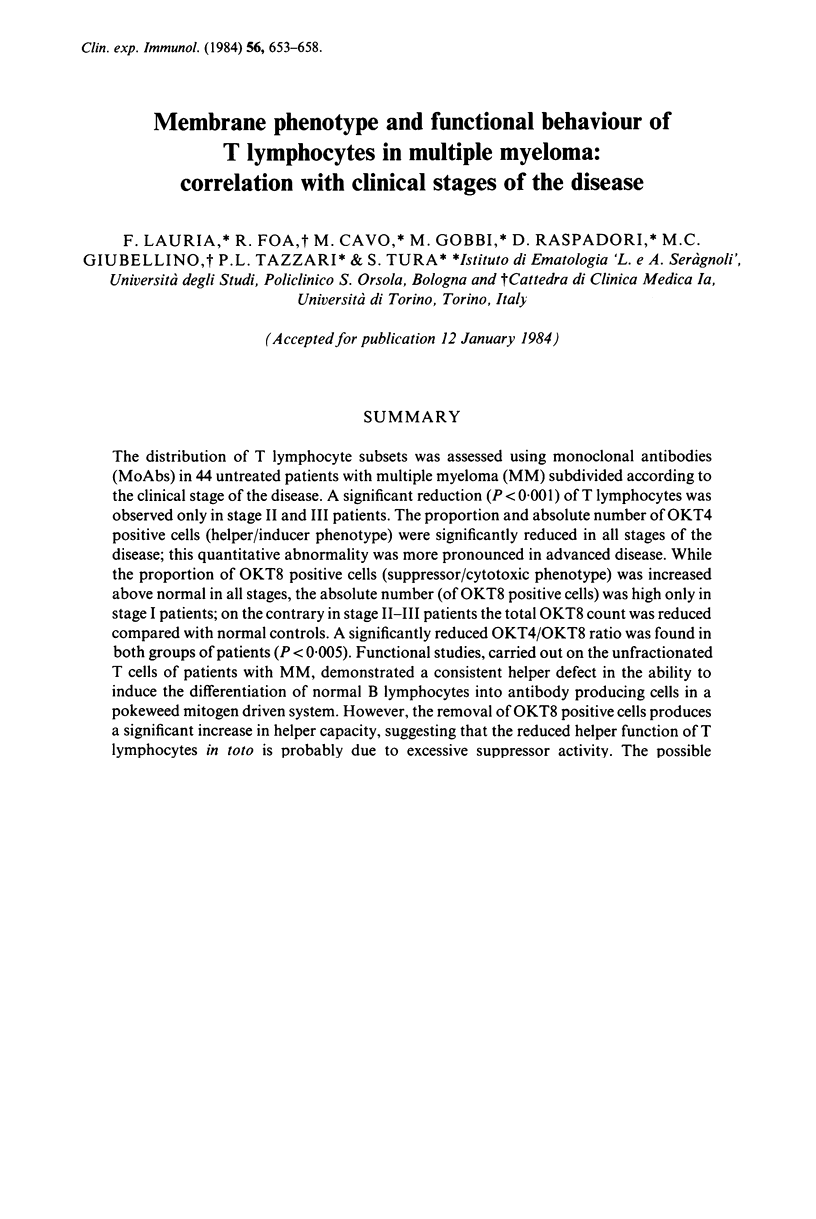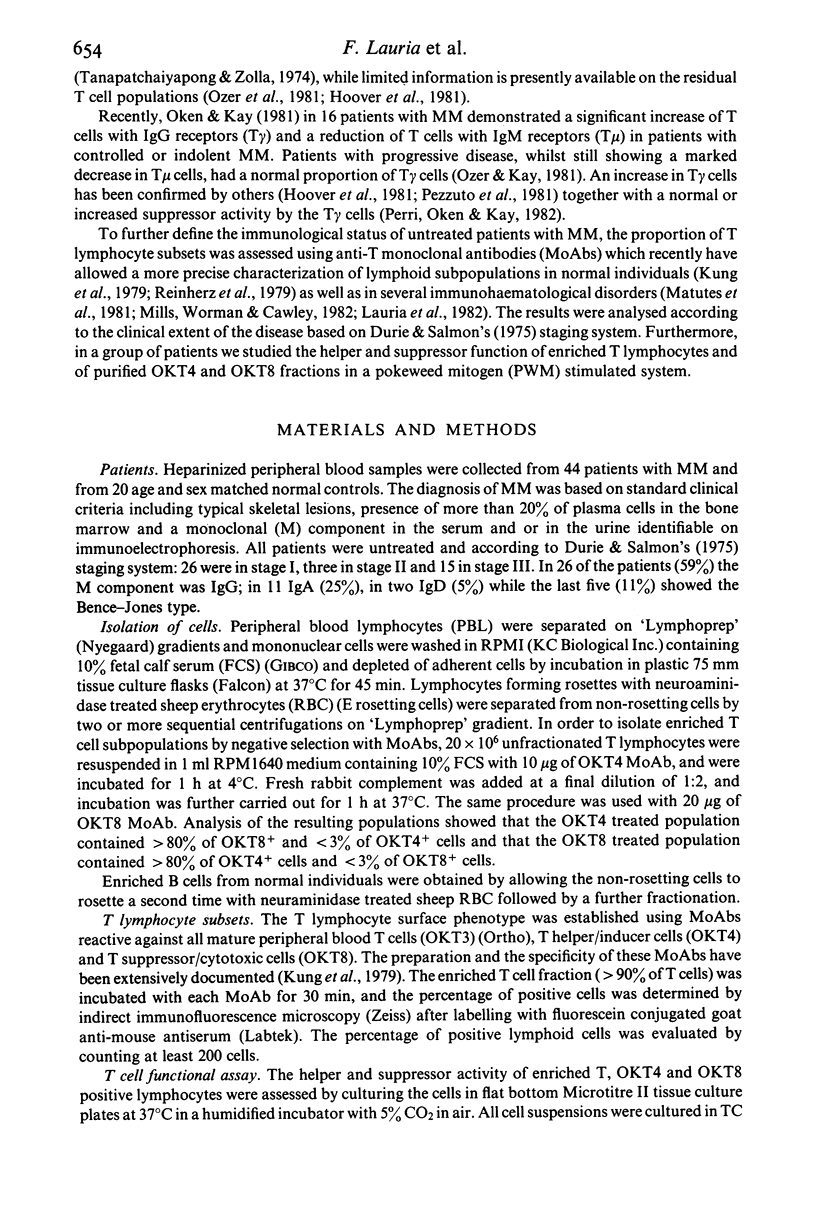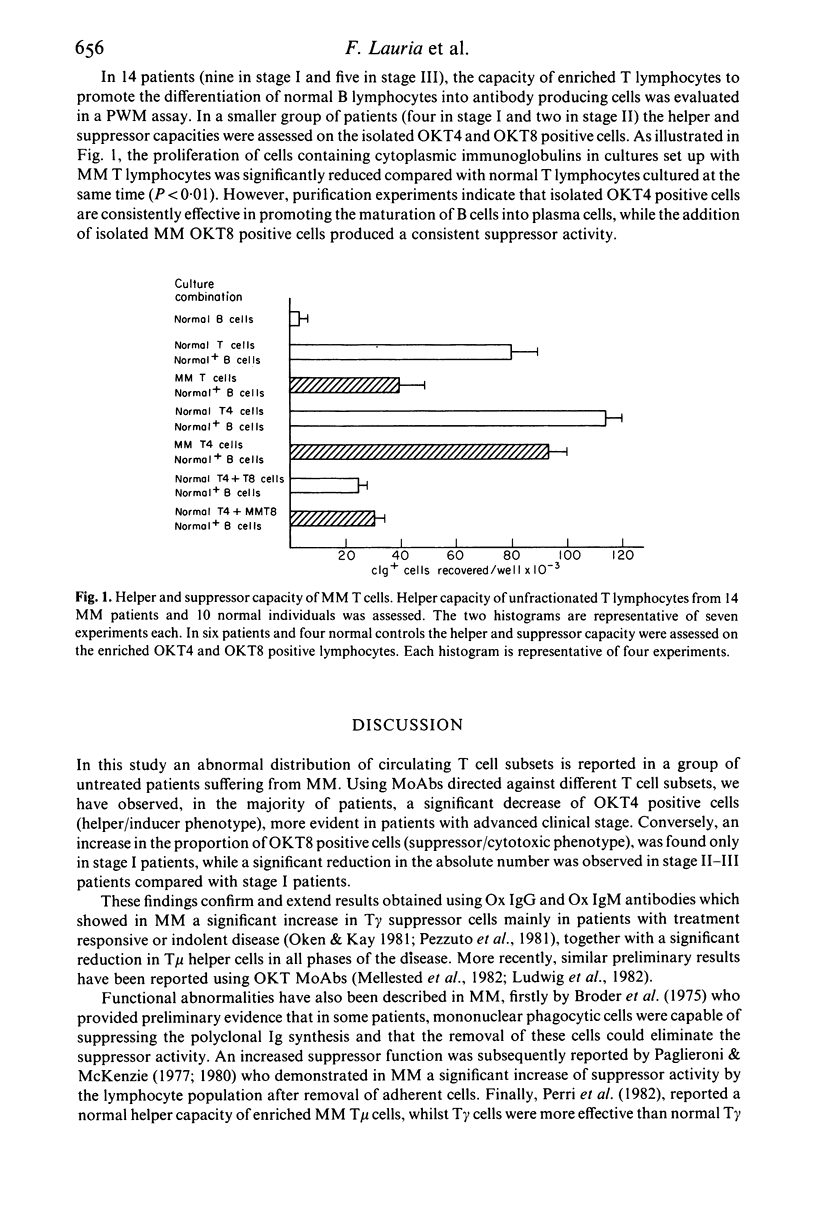Abstract
The distribution of T lymphocyte subsets was assessed using monoclonal antibodies (MoAbs) in 44 untreated patients with multiple myeloma (MM) subdivided according to the clinical stage of the disease. A significant reduction (P less than 0.001) of T lymphocytes was observed only in stage II and III patients. The proportion and absolute number of OKT4 positive cells (helper/inducer phenotype) were significantly reduced in all stages of the disease; this quantitative abnormality was more pronounced in advanced disease. While the proportion of OKT8 positive cells (suppressor/cytotoxic phenotype) was increased above normal in all stages, the absolute number (of OKT8 positive cells) was high only in stage I patients; on the contrary in stage II-III patients the total OKT8 count was reduced compared with normal controls. A significantly reduced OKT4/OKT8 ratio was found in both groups of patients (P less than 0.005). Functional studies, carried out on the unfractionated T cells of patients with MM, demonstrated a consistent helper defect in the ability to induce the differentiation of normal B lymphocytes into antibody producing cells in a pokeweed mitogen driven system. However, the removal of OKT8 positive cells produces a significant increase in helper capacity, suggesting that the reduced helper function of T lymphocytes in toto is probably due to excessive suppressor activity. The possible immunoregulatory role of MM T cell disease is discussed.
Full text
PDF





Selected References
These references are in PubMed. This may not be the complete list of references from this article.
- Broder S., Humphrey R., Durm M., Blackman M., Meade B., Goldman C., Strober W., Waldmann T. Impaired synthesis of polyclonal (non-paraprotein) immunoglobulins by circulating lymphocytes from patients with multiple myeloma Role of suppressor cells. N Engl J Med. 1975 Oct 30;293(18):887–892. doi: 10.1056/NEJM197510302931801. [DOI] [PubMed] [Google Scholar]
- CONE L., UHR J. W. IMMUNOLOGICAL DEFICIENCY DISORDERS ASSOCIATED WITH CHRONIC LYMPHOCYTIC LEUKEMIA AND MULTIPLE MYELOMA. J Clin Invest. 1964 Dec;43:2241–2248. doi: 10.1172/JCI105098. [DOI] [PMC free article] [PubMed] [Google Scholar]
- Durie B. G., Salmon S. E. A clinical staging system for multiple myeloma. Correlation of measured myeloma cell mass with presenting clinical features, response to treatment, and survival. Cancer. 1975 Sep;36(3):842–854. doi: 10.1002/1097-0142(197509)36:3<842::aid-cncr2820360303>3.0.co;2-u. [DOI] [PubMed] [Google Scholar]
- FAHEY J. L., SCOGGINS R., UTZ J. P., SZWED C. F. INFECTION, ANTIBODY RESPONSE AND GAMMA GLOBULIN COMPONENTS IN MULTIPLE MYELOMA AND MACROGLOBULINEMIA. Am J Med. 1963 Nov;35:698–707. doi: 10.1016/0002-9343(63)90140-2. [DOI] [PubMed] [Google Scholar]
- Hoover R. G., Hickman S., Gebel H. M., Rebbe N., Lynch R. G. Expansion of Fc receptor-bearing T lymphocytes in patients with immunoglobulin G and immunoglobulin A myeloma. J Clin Invest. 1981 Jan;67(1):308–311. doi: 10.1172/JCI110028. [DOI] [PMC free article] [PubMed] [Google Scholar]
- Kubagawa H., Vogler L. B., Capra J. D., Conrad M. E., Lawton A. R., Cooper M. D. Studies on the clonal origin of multiple myeloma. Use of individually specific (idiotype) antibodies to trace the oncogenic event to its earliest point of expression in B-cell differentiation. J Exp Med. 1979 Oct 1;150(4):792–807. doi: 10.1084/jem.150.4.792. [DOI] [PMC free article] [PubMed] [Google Scholar]
- Kung P., Goldstein G., Reinherz E. L., Schlossman S. F. Monoclonal antibodies defining distinctive human T cell surface antigens. Science. 1979 Oct 19;206(4416):347–349. doi: 10.1126/science.314668. [DOI] [PubMed] [Google Scholar]
- Lauria F., Foa R., Gobbi M., Pulvirenti A., Raspadori D., Giubellino M. C., Tura S. Characterization of T-lymphocyte subsets in hairy-cell leukaemia (HCL) by monoclonal antibodies: comparison with Fc gamma, Fc mu receptors and correlation with disease activity. Br J Haematol. 1982 Dec;52(4):657–662. doi: 10.1111/j.1365-2141.1982.tb03942.x. [DOI] [PubMed] [Google Scholar]
- Matutes E., Wechsler A., Gomez R., Cherchi M., Catovsky D. Unusual T-cell phenotype in advanced B-chronic lymphocytic leukaemia. Br J Haematol. 1981 Dec;49(4):635–642. doi: 10.1111/j.1365-2141.1981.tb07274.x. [DOI] [PubMed] [Google Scholar]
- Mellstedt H., Holm G., Pettersson D., Björkholm M., Johansson B., Lindemalm C., Peest D., Ahre A. T cells in monoclonal gammopathies. Scand J Haematol. 1982 Jul;29(1):57–64. doi: 10.1111/j.1600-0609.1982.tb00563.x. [DOI] [PubMed] [Google Scholar]
- Mills K. H., Worman C. P., Cawley J. C. T-cell subsets in B-chronic lymphocytic leukaemia (CLL) Br J Haematol. 1982 Apr;50(4):710–712. doi: 10.1111/j.1365-2141.1982.tb01974.x. [DOI] [PubMed] [Google Scholar]
- Oken M. M., Kay N. E. T-cell subpopulations in multiple myeloma: correlation with clinical disease status. Br J Haematol. 1981 Dec;49(4):629–634. doi: 10.1111/j.1365-2141.1981.tb07273.x. [DOI] [PubMed] [Google Scholar]
- Ozer H., Han T., Henderson E. S., Nussbaum A., Sheedy D. Immunoregulatory T cell function in multiple myeloma. J Clin Invest. 1981 Mar;67(3):779–789. doi: 10.1172/JCI110095. [DOI] [PMC free article] [PubMed] [Google Scholar]
- Paglieroni T., MacKenzie M. R. Studies on the pathogenesis of an immune defect in multiple myeloma. J Clin Invest. 1977 Jun;59(6):1120–1133. doi: 10.1172/JCI108736. [DOI] [PMC free article] [PubMed] [Google Scholar]
- Paglieroni T., Mackenzie M. R. Multiple myeloma: an immunologic profile. Cytotoxic and suppressive effects of the EA rosette-forming cell. J Immunol. 1980 Jun;124(6):2563–2570. [PubMed] [Google Scholar]
- Perri R. T., Oken M. M., Kay N. E. Enhanced T cell suppression is directed toward sensitive circulating B cells in multiple myeloma. J Lab Clin Med. 1982 Apr;99(4):512–519. [PubMed] [Google Scholar]
- Reinherz E. L., Kung P. C., Goldstein G., Schlossman S. F. Separation of functional subsets of human T cells by a monoclonal antibody. Proc Natl Acad Sci U S A. 1979 Aug;76(8):4061–4065. doi: 10.1073/pnas.76.8.4061. [DOI] [PMC free article] [PubMed] [Google Scholar]
- Salmon S. E. Immunoglobulin synthesis and tumor kinetics of multiple myeloma. Semin Hematol. 1973 Apr;10(2):135–144. [PubMed] [Google Scholar]
- Tanapatchaiyapong P., Zolla S. Humoral immunosuppressive substance in mice bearing plasmacytomas. Science. 1974 Nov 22;186(4165):748–750. doi: 10.1126/science.186.4165.748. [DOI] [PubMed] [Google Scholar]


